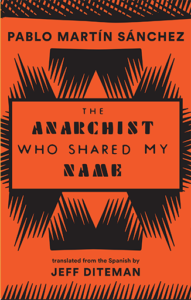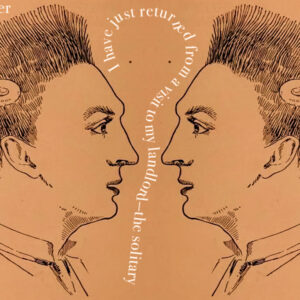
In Search of the Anarchist Who Shared My Name
Pablo Martín Sánchez on Writing a Novel About the Other Pablo Martín Sánchez
There is something exciting and at the same time terrifying about the idea that chance can govern our lives. Exciting, because it is part of the very adventure of living; terrifying, because it produces a dizzy feeling of lack of control. When it comes to writing, chance tends to play a smaller role than most people think—although some authors have made it the protagonist of their whole body of work. The story you hold in your hands, however, would not have been possible if chance had not knocked insistently at the writer’s door. Or, to put it more accurately: this story would not exist as it is retold here. Most of the facts can be dug up in archives and periodicals libraries, those flowerless cemeteries of memory. But an untold story is a story that does not yet exist: someone has to weave together the thread of the events. And chance or coincidence intervened in my path so that I would be the one to do so. Because this is the story of someone who may have been my great-grandfather. It is the story of an anarchist who shared my name. It is the story of Pablo Martín Sánchez, a story that is perhaps worth telling.
*
It all began the day I googled my name for the first time. Back then, I was a young, unpublished author who blamed his failure on the ordinariness of his name. And the search engine proved me right: I entered “Pablo Martín Sánchez,” and the screen vomited up hundreds of results. References to me did show up here and there, amid the motley list of surfers, chess players, and reckless drivers facing prosecution. But there was one entry that particularly grabbed my attention, perhaps because it was written in French: “International dictionary of anarchist militants (from Gh to Gil),” said the title, followed by this stub: “Captured, condemned to death and executed with other participants in the action including Julián Santillán Rodríguez and Pablo Martín Sánchez…” Intrigued, I opened the page and discovered that it was an article about the anarchist Enrique Gil Galar, with a passing mention of Pablo Martín Sánchez. I then tried to access the letter M for Martín, but the dictionary was under construction and only went up to G. However, the entry on Gil Galar shed a bit more light on the text of the stub: “Member of an action group, Enrique Gil Galar participated on November 6 and 7, 1924, in the Vera de Bidasoa expedition in which one hundred comrades coming from France penetrated Spain.”
I was unable to find any other references online, but for a few months I kept going back to the anarchist militants page to watch the progress of their dictionary. Unfortunately, their pace of work was hopelessly slow, and it seemed it would take years for them to reach the letter M. Finally, I wrote to them asking for more information about Pablo Martín Sánchez. Their polite reply, which I have kept, reads: “Hello and thank you for your letter. However, I do not have any more information about Pablo Sánchez Martín [sic]. Perhaps you should look in Spanish newspapers from the time and in the legal archives. Sincerely yours, R. Dupuy.” And that is exactly what I did: I tracked down periodicals from the time at the National Library, consulted dozens of books about the events in Vera de Bidasoa, and traveled to the very site of the incidents. Only then did I understand that I had to write the story of this anarchist who had stolen my name.
“It all began the day I googled my name for the first time. Back then, I was a young, unpublished author who blamed his failure on the ordinariness of his name.”
However, it didn’t make much sense to limit myself to recounting what had happened in 1924. Other, more prominent writers had already done so, including Don Pío Baroja in La Familia de Errotacho, written in his study in the farmhouse of Itzea, with a view overlooking the path that the revolutionaries took on November 6 and 7. What I needed to do was something that no one had ever done before: reconstruct the biography of Pablo Martín Sánchez. But the task was not going to be simple, because, although his participation in the events in Vera was well documented, little was known about his previous life, perhaps due to having been unremarkable, like the lives of the vast majority of people, although his end made its way into the newspapers. In fact, one of the few pieces of information I had was that he was born in Baracaldo, so I decided to start my search at the beginning: the civil registry. And that’s where I went one rainy autumn day.
There was a line at the registry. I waited impatiently for my turn. When I reached the window, I asked for the birth record of Pablo Martín Sánchez. “Date?” asked the young woman behind the window. “I don’t know exactly,” I replied. “Well, without the date of birth, we can’t do anything.” Then I remembered that the chronicles of the events stated that Pablo was 25 years old at the time of the incursion. “Around 1899,” I ventured. “I’ll go check,” said the woman, and she stood up to consult an enormous binder. She came back, shaking her head: in 1899 there was no one registered with that name. “What about 1900?” I asked. But although the woman looked in all of the volumes between 1895 and 1905, the closest match she found was a certain Pablo Martínez Santos, who died from respiratory collapse just a few days after being born. When I noticed that the people in the line were starting to grow impatient, I said thank you and left, without paying much attention to the face of the woman who had helped me. That’s why I didn’t recognize her when, that same night, she walked up to my table at the bar Txalaparta, where I was ruminating on the strategy I would use the next day, and, with a mischievous smile, snapped me out of my reverie, saying, “I didn’t think you’d survive till evening.” Seeing my confused look, she continued, “Man, you left the registry
so depressed, I thought you were going to commit suicide as soon as you got home.” I invited her to sit down, but she was celebrating a birthday with some girlfriends, so she said she would only linger a few minutes. I told her the story that had brought me to Baracaldo, trying to explain my frustration that morning, and she told me to look at the parish baptismal records, which were sometimes more reliable than the data in the registry. She wished me luck and said goodbye with a pair of cheek kisses. Only then did I realize that I hadn’t even asked her name.
“I tracked down periodicals from the time at the National Library, consulted dozens of books about the events in Vera de Bidasoa, and traveled to the very site of the incidents. Only then did I understand that I had to write the story of this anarchist who had stolen my name.”
The next day, I went back to the registry, but instead of the young woman with the mischievous smile, I was assisted by a chubby, sweaty guy. I asked after her, and he told me she was ill. So I wrote a note on a piece of paper, signed it with my email address, and asked him to leave it somewhere for her, if he would be so kind. Two days later, after running around to all of the churches, I returned to my hotel room empty-handed. I didn’t know where to look next. Just when I was about to give up, a message came that renewed my hope: it was the woman with the mischievous smile (I will keep calling her that, out of respect for her desire for anonymity). She said that she had taken an interest in my story, and since the hours at the registry seemed interminable, she had been poking around in the archives and had found a certain Pablo Martín Sánchez born on January 26, 1890. She didn’t think it was the person I was looking for, but who knows, maybe it was. In addition, she had told the story to her grandfather, making him promise that he would ask around at the community center to see if anyone had heard of him. I wrote her back immediately, thanking her and thinking that, once again, chance or coincidence had crossed my path. If, instead of going to the Txalaparta that night, I had gone to the Tempus Fugit, it is quite likely that you, dear reader, would be holding a different book in your hands right now, instead of mine.
The information that the woman with the mischievous smile had found in the civil registry was correct: it was the Pablo Martín Sánchez I was looking for, born quite a while before what was stated in the chronicles of the time (a generalized error, which there will be time enough to explain). In addition, the woman’s grandfather put the word out at the community center, and got some results. One of the elders of Baracaldo who met every afternoon to play the card game mus knew someone from a nearby village who had a cousin whose father had been in France during the Primo de Rivera dictatorship, participating in some of the secret meetings where they plotted to overthrow the regime. The man had died a few years before, almost a centenarian, but his son still remembered some of the stories he had told. The problem was that he lived in Boston, Massachusetts, and I could not afford the luxury of traveling all that way to interview him; the most I could do was write him a letter, which never received a reply. But the elders of the community center refused to give up; excited by this story that seemed to give them back the energy of youth, they kept putting the word out all over Baracaldo. The woman with the mischievous smile sometimes went to see them and kept me informed of their progress, amused by the stories that these “geriatric bloodhounds,” as she called them, were telling her. So I barely had to do anything; they cast the net all by themselves, and one fine day I received word that they had found someone who could tell me a lot about the story: a niece of Pablo Martín Sánchez, over 90 years old and a notorious misanthrope, who lived in a senior citizens’ home in Durango, about 30 kilometers southeast of Bilbao.
You might think, dear reader, that I ought to have felt overjoyed at that moment, but I must confess that all I felt was fear. Yes, an inexplicable fear, a vague fear. Fear of looking into the story only to learn that it was boring, fear of finally speaking with this niece and having to accept that there was no story there to tell, fear of discovering that my namesake the anarchist had been an insignificant person or a second-rate delinquent who signed up for the Vera mission with petty intentions. For a moment I thought about staying home and forgetting the whole thing. But my curious side ended up winning over the cowardly part that was holding me back, and I undertook another trip, this time to Durango. On a cold but sunny Saturday at the end of January, I went to the Uribarri retirement home. They made me wait for a few minutes and then accompanied me to the garden, where the niece of Pablo Martín Sánchez was waiting for me on a bench, half dozing. Her head barely emerged through the collar of the thick green coat she was wrapped in, which gave her the curious appearance of a tortoise sleeping in the sun. The nurse gently rubbed her shoulder, and the old woman stretched her neck out toward us, unhurriedly opening her eyes behind thick glasses. She scrutinized me for a few moments before smiling. From her shell emerged a wrinkled hand gleaming
with a strange, T-shaped ring, and she extended it to me in a friendly manner, saying, “Teresa, at your service.” Without pause, she continued in the same soft voice: “Please, do sit down.”
“I barely had to do anything; they cast the net all by themselves, and one fine day I received word that they had found someone who could tell me a lot about the story: a niece of Pablo Martín Sánchez, over 90 years old and a notorious misanthrope, who lived in a senior citizens’ home in Durango, about 30 kilometers southeast of Bilbao.”
This encounter inaugurated a series of visits that extended into the following autumn: the first Saturday of every month I went up to Durango to listen to Teresa, the niece of Pablo Martín Sánchez, and the woman to whom I owe at least half of this book, because practically everything I know about the life of her uncle up until the moment he decided to enlist in the revolutionary expedition comes from the inexhaustible fountain of her memory, which was sparkling clear at first, although it grew foggier with each of our sessions. And thus, completely giving the lie to the misanthropic reputation some had pinned on her, she offered me, in nearly perfect chronological order, the story of the life (or what she remembered others having told her about the life) of her uncle the anarchist.
The last session was scheduled for All Hallows’ Eve. At the previous visit the nurse had informed me that Teresa’s health had been worsening a lot recently, and that the efforts of memory that my visits required might be harmful. I went to the home in the early afternoon, with a box of chocolates in my hand and a knot in my stomach. I was seized by a strange mixture of sadness and relief; sadness at the idea of putting an end to these pleasant meetings, and relief at being about to complete the puzzle of a story that would turn into a book. The life of Pablo Martín Sánchez had turned out to be one of the most fascinating I had ever heard, and the old woman had promised me that at our final meeting, she would tell me one “last surprise,” smiling mischievously and half-closing her eyes behind her
thick glasses. But when I asked for her at the reception, the unexpected news of her death struck me such a blow that I feared I would lose my balance. Despite her age and her declining health, I had believed her to be indestructible. “She died last week,” they told me, “Peacefully, in her sleep.” They regretted not having been able to let me know, but they did not have my telephone number. I thanked them and left the residence home, with the box of chocolates in my hand. Crossing the threshold, I heard someone say my name. I turned around. It was the nurse, with an envelope in her hand. On the back, it said “For Pablo.” “We found it in Teresa’s bedside table,” said the nurse. “I think it was for you.” I looked in her eyes, and I don’t know why, but all I could manage to do was hug her. Probably because I couldn’t find any words.
On the street, I sat down on a bench and opened the envelope. Inside, there was an old photograph, very well preserved, as though someone had kept it carefully for a long time. It showed three people: a handsome man, a dark-haired woman, and a teenage girl, embracing each other and leaning against a stylish delivery truck from the 1920s, which showed that the phenomenon of advertisement had already arisen: visible over their heads was a drawing of a large cow’s head with earrings, along with the brand name: “La vache qui rit.” Studying the picture, I discovered that this man was the same one I had seen in the National Historic Archive, on one of the anthropometric files compiled by the police after the Vera incident: none other than Pablo Martín Sánchez, my namesake the anarchist. I did not recognize the mother or the teenager, but I supposed they were his sister and his niece, Teresa herself, although she looked nothing like the old woman who had opened up the bounty of her memories to me. Upon returning the photograph to the envelope, I discovered that there was also a scrap of paper, on which she had written, as if at the last minute: “Thank you for everything, Pablo. My uncle would have laughed out loud if he knew he would end up being the protagonist of a novel.”
The least I can do is dedicate this book to Teresa, and offer her my gratitude for having made it possible for you, dear reader, to bring to life once again the story of her uncle the anarchist.
__________________________________

From The Anarchist Who Shared My Name. Courtesy of Deep Vellum. Copyright © 2018 by Pablo Martín Sánchez. English translation copyright © 2018 by Jeff Diteman.
Pablo Martín Sánchez
Pablo Martín Sánchez was born in Reus, Spain in 1977. He graduated from the Institut del Teatre de Barcelona with a degree in Dramatic Art and from the University of Barcelona with a degree in Literary Theory and Comparative Literature. He received a Master’s degree in Humanities from the Carlos III University of Madrid and a Ph.D. in French Language and Literature from the University of Lille-3 as well as a a Ph.D. in Literary Theory and Art and Comparative Literature from the University of Granada. He is the author a collection of short stories, Fricciones (E.D.A. Libros, 2011), and two novels, The Anarchist Who Shared My Name (El anarquista que se llamaba como yo) and Tuyo es el mañana (Acantilado, 2016). In addition, he has translated the works of authors such as Alfred Jarry, Raymond Queneau, and Wajdi Mouawad, and teaches writing at the Ateneu School of Writing of Barcelona. In 2014 he was invited to join the Oulipo and is currently the only Spanish member of the group. The English translation of The Anarchist Who Shared My Name is available now from Deep Vellum.


















